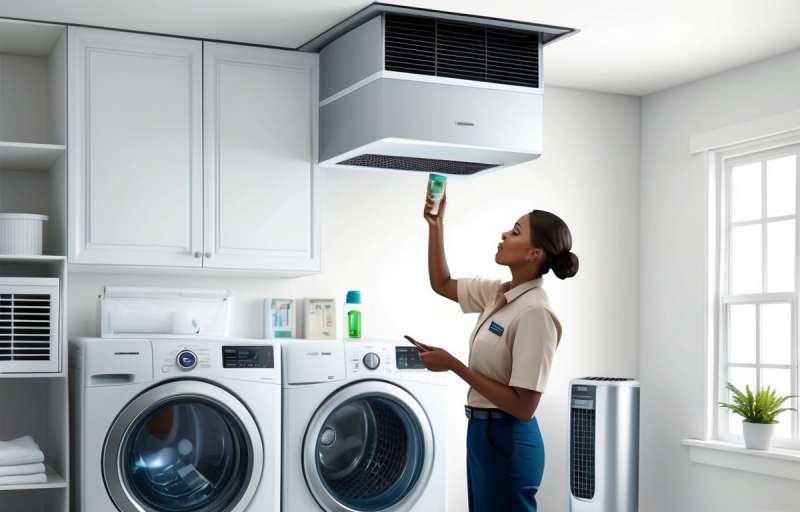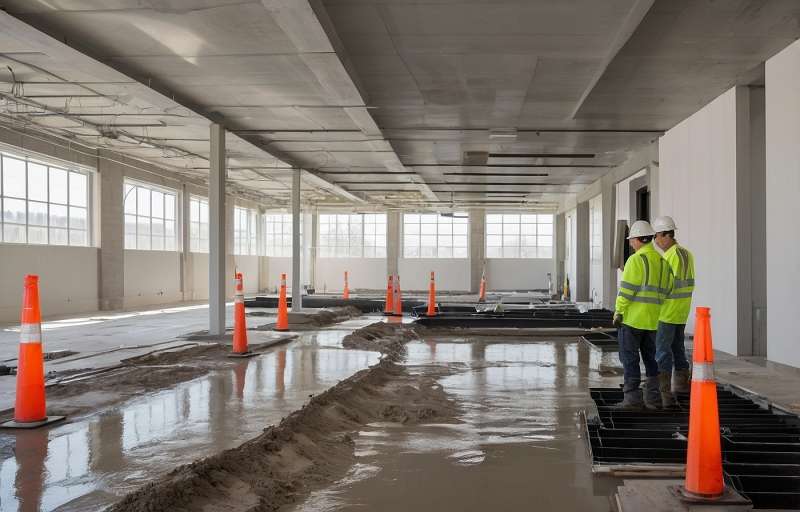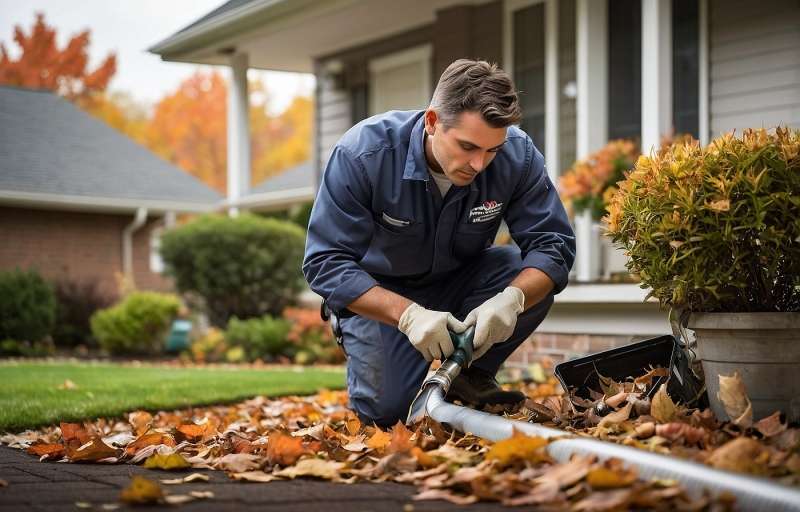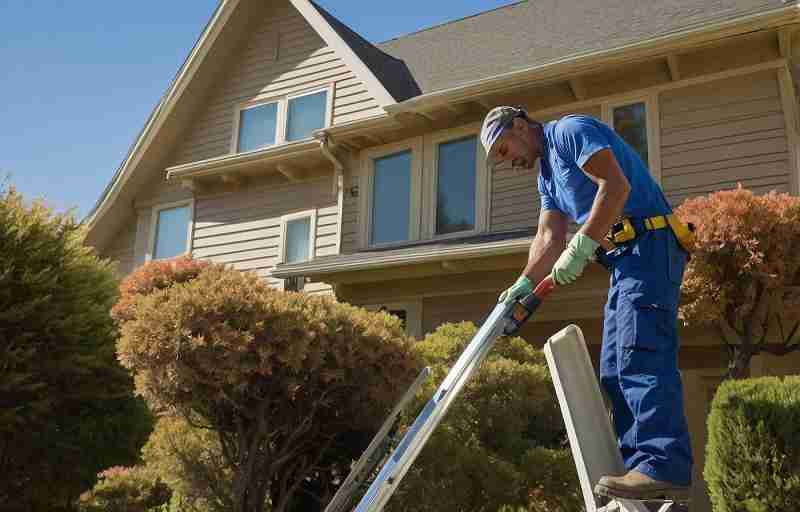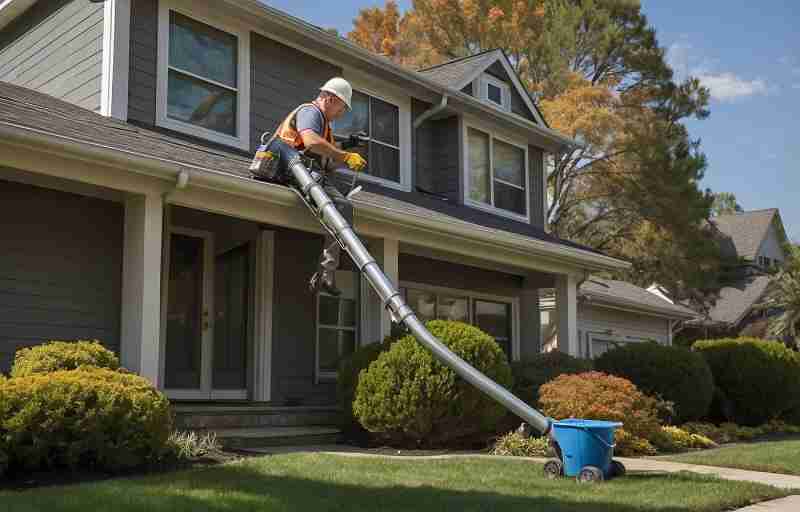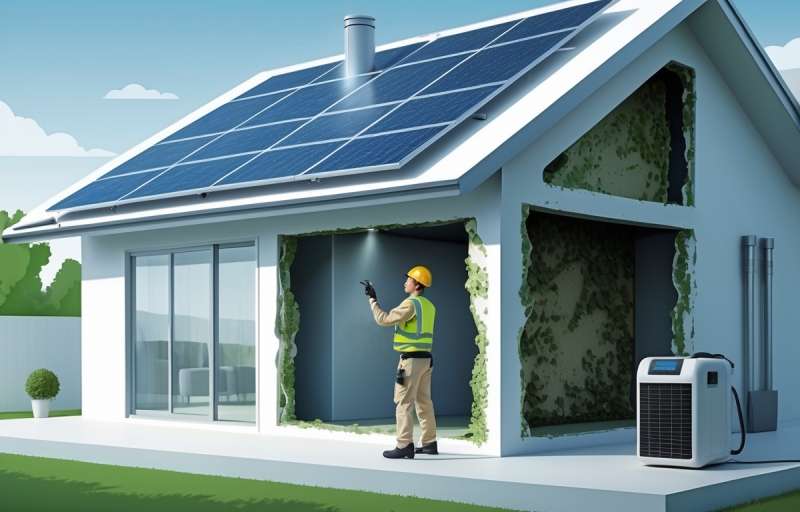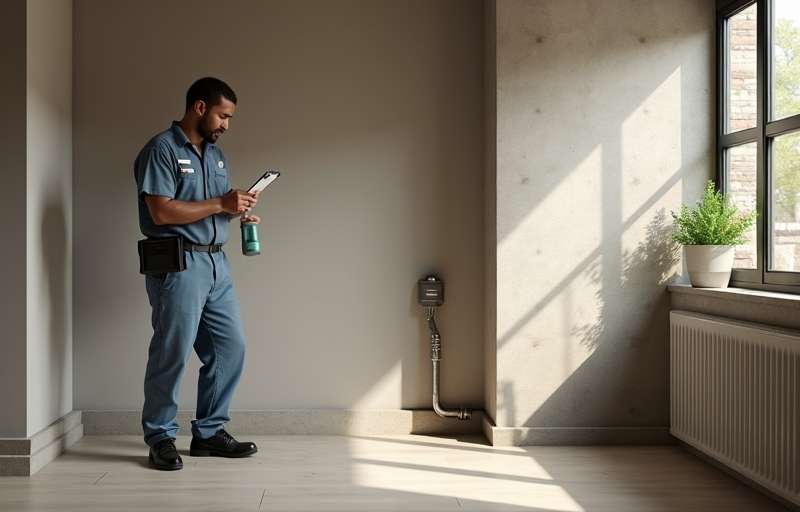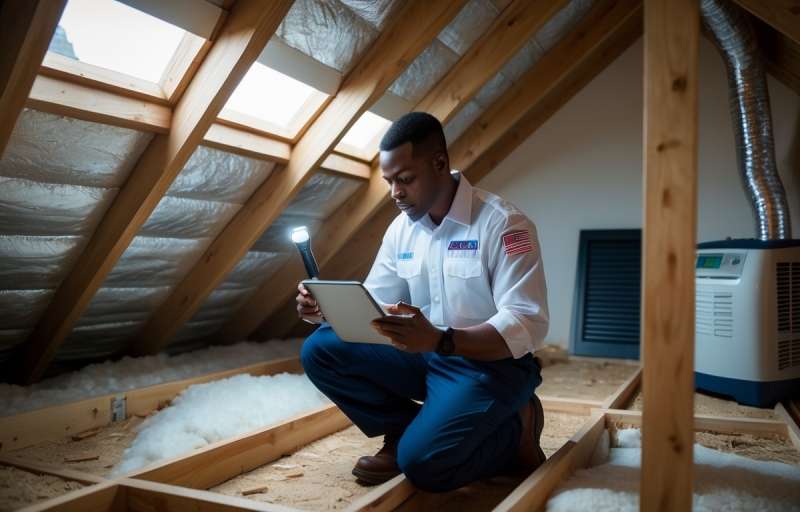As a new homeowner, protecting your investment is a top priority—and one of the most critical aspects of home maintenance is water damage prevention. Water damage can strike unexpectedly, whether from a burst pipe, heavy rainfall, or a leaking appliance, leading to costly repairs and long-term structural issues. Understanding how to prevent water damage not only safeguards your property but also ensures a healthier living environment for you and your family. At COMMITTED TO QUALITY SERVICE, we specialize in fast, friendly, and professional water damage restoration services, using advanced equipment designed specifically for drying and restoring affected structures. Whether you’re dealing with a minor leak or a major flood, our expert team is here to help. Call us now at 855-933-7935 to learn more about how we can protect your home from water damage and provide peace of mind. Don’t wait until it’s too late—take proactive steps today to prevent water damage and keep your home safe and sound.
Understanding the Risks of Water Damage
Water damage is one of the most common and costly issues that new homeowners face. It can strike suddenly due to natural disasters like floods or gradually through unnoticed leaks and poor maintenance. Understanding the risks associated with water damage is crucial for protecting your investment, maintaining a safe living environment, and avoiding expensive repairs. Many new homeowners underestimate the potential severity of water damage, often focusing more on cosmetic upgrades than on structural integrity and moisture control. However, the consequences of ignoring water-related issues can be devastating.
Water damage can originate from a variety of sources, including plumbing failures, roof leaks, foundation cracks, and even high indoor humidity levels. Each of these sources presents unique challenges and risks. For example, a small leak under a sink might seem insignificant at first but can lead to mold growth, wood rot, and even structural damage over time. According to the Insurance Information Institute, water damage and freezing account for nearly 29 percent of all homeowner insurance claims in the United States. This statistic underscores the importance of early detection and prevention.
One of the most insidious aspects of water damage is that it often goes unnoticed until it has already caused significant harm. Hidden leaks behind walls, under floors, or in attics can persist for months before any visible signs appear. By the time discoloration, warping, or a musty odor becomes evident, the damage may already be extensive. This is why it is essential for homeowners to educate themselves on how to identify hidden water damage early. For more information on this topic, visit our guide on how to identify hidden water damage early.
The risks of water damage extend beyond structural issues. Mold growth is a common consequence of prolonged moisture exposure and can pose serious health risks, especially for individuals with allergies, asthma, or compromised immune systems. The Centers for Disease Control and Prevention (CDC) warns that mold can begin to grow within 24 to 48 hours of water exposure. Once established, mold can be difficult and costly to remove. It can also spread quickly, contaminating air ducts, furniture, and personal belongings.
In addition to health concerns, water damage can significantly reduce the value of your home. Potential buyers are often wary of properties with a history of water issues, even if repairs have been made. A home inspection revealing past water damage can lead to reduced offers or even the loss of a sale. Therefore, proactive prevention and timely remediation are not just about maintaining your home’s condition but also about preserving its market value.
To better understand the various ways water damage can occur, consider the following common scenarios:
- Leaking or burst pipes due to aging plumbing or freezing temperatures
- Roof damage from storms or clogged gutters causing water to seep into the attic
- Poor drainage around the foundation leading to basement flooding
- Malfunctioning appliances such as washing machines, dishwashers, or water heaters
- HVAC system condensation or blocked drains causing moisture buildup
Each of these situations can lead to significant damage if not addressed promptly. Regular maintenance, inspections, and awareness are key to minimizing these risks. For example, inspecting your roof annually and cleaning gutters can prevent water from entering your home during heavy rains. Similarly, ensuring that your plumbing is in good condition and that appliances are properly installed and maintained can reduce the likelihood of leaks.
Another critical aspect of water damage risk is the potential for electrical hazards. Water and electricity are a dangerous combination, and water intrusion can compromise electrical systems, leading to short circuits, fires, or electrocution. If you suspect water has come into contact with your electrical wiring or outlets, it is essential to shut off the power and contact a professional immediately.
Homeowners should also be aware of the long-term financial implications of water damage. Repairing water-damaged areas can be expensive, especially if structural components like beams, drywall, or flooring need to be replaced. Additionally, if mold remediation is required, the costs can escalate quickly. Insurance may cover some of these expenses, but policies often have limitations and exclusions. It is advisable to review your homeowner’s insurance policy to understand what is covered and consider additional coverage if you live in a high-risk area.
Preventing water damage requires a proactive approach. This includes regular inspections, timely repairs, and investing in preventive measures such as sump pumps, water leak detectors, and proper landscaping to direct water away from the foundation. For a comprehensive overview of the services available to help protect your home, visit our services page.
It is also beneficial to familiarize yourself with the signs of water damage so you can act quickly when issues arise. These signs include:
- Discoloration or staining on walls and ceilings
- Warped or buckling floors
- Peeling paint or wallpaper
- Musty odors indicating mold or mildew
- Unexplained increases in water bills
Being vigilant and addressing these signs early can save you time, money, and stress. If you are unsure about the extent of potential damage or how to proceed, consulting with a professional restoration company can provide peace of mind. Learn more about our approach and commitment to quality by visiting our our mission page.
“The best way to deal with water damage is to prevent it from happening in the first place. Awareness, maintenance, and quick action are your best defenses.”
In conclusion, understanding the risks of water damage is essential for new homeowners. It is not just about fixing problems when they occur but about implementing strategies to prevent them. From health hazards and structural damage to financial loss and decreased property value, the consequences of water damage are far-reaching. By staying informed and proactive, you can protect your home and ensure a safe, comfortable living environment for years to come.
For additional tips and expert advice, explore our detailed resources on the blog or reach out through our contact page to speak with a water damage specialist.
Common Causes of Water Damage in Homes
Water damage is one of the most common and costly issues new homeowners face, often occurring without warning and leading to significant repairs if not addressed promptly. Understanding the typical causes of water damage is essential for prevention and long-term home maintenance. One of the leading culprits is plumbing system failures. Leaky pipes, worn-out hose connections, and broken pipe joints can all lead to gradual or sudden water leaks. These issues often go unnoticed behind walls or under floors until the damage becomes extensive. Regular inspections and timely repairs of your plumbing system are crucial to avoid such problems.
Another frequent source of water damage is roof leaks. Over time, roofing materials can deteriorate due to weather exposure, poor installation, or lack of maintenance. Missing shingles, cracked flashing, or clogged gutters can allow water to seep into the attic and walls, causing structural damage and mold growth. Homeowners should schedule regular roof inspections, especially after severe weather events, to ensure their roofing system remains intact and functional.
Appliances are also a common cause of water damage in homes. Washing machines, dishwashers, water heaters, and refrigerators with ice makers are all connected to water lines and can malfunction or develop leaks. Aging appliances or those with faulty connections can release large volumes of water in a short time. It is advisable to check hoses and connections regularly and replace them as needed. Installing water leak detectors near these appliances can also provide an early warning and help prevent extensive damage.
Poor drainage around the foundation of a home is another significant contributor to water damage. When water is not directed away from the house, it can pool around the foundation and eventually seep into the basement or crawl space. This can lead to structural issues, mold growth, and even foundation cracks. Ensuring proper grading around the home, maintaining clean gutters and downspouts, and installing a sump pump if necessary are effective ways to manage water flow and protect your home’s foundation.
Weather-related events such as heavy rainfall, snowmelt, and flooding can also lead to water damage. While these natural occurrences are beyond a homeowner’s control, there are steps that can be taken to minimize their impact. Installing a sump pump, sealing cracks in the foundation, and using flood barriers or sandbags during extreme weather can help reduce the risk. Additionally, understanding your home’s flood risk and having adequate insurance coverage can provide peace of mind and financial protection.
HVAC systems, particularly air conditioners, can also be a hidden source of water damage. When not properly maintained, condensation from these systems can accumulate and overflow, especially if the drain lines are clogged. This can lead to water pooling in ceilings, walls, or floors, causing damage and promoting mold growth. Regular maintenance of your HVAC system, including cleaning and inspecting drain lines, is essential to prevent such issues.
Clogged gutters and downspouts are often overlooked but can have a significant impact on water damage. When gutters are filled with leaves, debris, or ice, they cannot effectively channel water away from the home. This can lead to water spilling over the sides and pooling around the foundation or leaking into the roof and walls. Cleaning gutters regularly and installing gutter guards can help maintain proper water flow and prevent damage.
Sewer backups are another potential cause of water damage that can be particularly hazardous due to the health risks associated with contaminated water. These backups can occur due to blockages in the main sewer line, tree root intrusion, or heavy rainfall overwhelming the municipal sewer system. Installing a backwater valve and avoiding flushing inappropriate items down the toilet can help prevent sewer backups and the resulting water damage.
Windows and doors that are not properly sealed can also allow water to enter the home, especially during storms or heavy rain. Over time, weather stripping and caulking can degrade, creating gaps that let water seep in. Inspecting and maintaining the seals around windows and doors is a simple yet effective way to prevent water intrusion and protect your home’s interior.
In some cases, water damage can be caused by construction defects or poor workmanship. Improperly installed roofing, plumbing, or waterproofing systems can lead to leaks and water infiltration. New homeowners should ensure that any construction or renovation work is performed by licensed and reputable contractors. It is also wise to have a thorough home inspection before purchasing a property to identify any potential issues.
Condensation is another often-overlooked source of water damage. In areas with high humidity, condensation can form on cold surfaces such as windows, pipes, and walls. Over time, this moisture can lead to mold growth and damage to building materials. Using dehumidifiers, improving ventilation, and insulating cold surfaces can help control condensation and reduce the risk of water damage.
Understanding these common causes of water damage is the first step toward effective prevention. New homeowners should take proactive measures to inspect and maintain their property regularly. Partnering with a trusted restoration company can also provide valuable support in identifying potential risks and addressing issues before they escalate. For more information about how we can help protect your home, visit our services page or learn more about our team and expertise. By staying informed and vigilant, you can safeguard your investment and enjoy peace of mind in your new home.
Inspecting Your Roof and Gutters Regularly
One of the most effective ways to prevent water damage in your new home is by consistently checking the condition of your roof and gutters. These components serve as the first line of defense against rain, snow, and other environmental elements that can lead to costly water-related issues if left unchecked. Your roof acts as a protective barrier, and your gutters are responsible for channeling water away from your home’s foundation. When either of these systems is compromised, water can seep into your attic, walls, or basement, leading to structural damage, mold growth, and other serious problems.
Start by visually inspecting your roof at least twice a year, ideally in the spring and fall. Look for missing, cracked, or curling shingles, as these are signs that your roof may be vulnerable to leaks. Pay attention to any sagging areas or dark spots, which could indicate trapped moisture or rotting materials beneath the surface. If your home has a flat roof, check for pooling water or debris buildup, which can accelerate wear and tear. Additionally, examine flashing around chimneys, vents, and skylights to ensure they are securely sealed and not allowing water to penetrate.
Gutters and downspouts should also be inspected and cleaned regularly. Clogged gutters can cause water to overflow and run down the sides of your home, potentially damaging siding, windows, and the foundation. Remove leaves, twigs, and other debris that may obstruct water flow, and make sure downspouts are directing water at least five to ten feet away from your home. Consider installing gutter guards to minimize the frequency of cleanings and reduce the risk of blockages. Also, check for signs of rust, sagging, or separation from the roofline, which may indicate that your gutter system needs repair or replacement.
Routine maintenance of your roof and gutters not only helps prevent water damage but also extends the lifespan of these critical components. If you are unsure about the condition of your roof or gutters, it is wise to consult a professional for a thorough inspection. Many homeowners overlook these areas until a problem arises, but proactive care can save you thousands of dollars in repairs and protect your investment in the long run.
For those new to homeownership, understanding the importance of these inspections is crucial. You can learn more about the types of services available to help maintain your home by visiting our services page. Additionally, if you are curious about our company’s values and commitment to quality, take a look at our our mission page. Regular inspections and timely maintenance are essential steps in safeguarding your home from the damaging effects of water intrusion.
Sealing Windows and Doors Properly
One of the most critical yet often overlooked aspects of water damage prevention for new homeowners is ensuring that all windows and doors are properly sealed. These entry points are among the most vulnerable areas in any home, and when not adequately sealed, they can allow rainwater, moisture, and even humidity to seep inside. Over time, this can lead to structural damage, mold growth, and costly repairs. Proper sealing not only protects your home from water intrusion but also improves energy efficiency by preventing drafts and heat loss.
When inspecting your home, start by checking the condition of the caulking and weatherstripping around all windows and doors. Caulking is a flexible material used to seal gaps and cracks, and it can deteriorate over time due to exposure to the elements. If you notice any cracks, gaps, or peeling, it is essential to remove the old caulk and apply a fresh, high-quality waterproof sealant. Weatherstripping, on the other hand, is typically made of rubber or foam and is used to seal the moving parts of doors and windows. Replacing worn or damaged weatherstripping can significantly reduce the risk of water infiltration.
Another important step is to examine the frames and sills for signs of rot, warping, or water stains. These issues may indicate that water has already penetrated the area, and immediate action is necessary to prevent further damage. In some cases, you may need to replace the entire window or door frame if the damage is extensive. Additionally, ensure that all exterior doors have proper thresholds and door sweeps installed. These components act as barriers to prevent water from entering underneath the door during heavy rain or flooding.
For homes located in areas prone to severe weather, consider installing storm windows or doors. These add an extra layer of protection and can help shield your primary windows and doors from wind-driven rain. Regular maintenance is also key. Make it a habit to inspect your windows and doors at least twice a year, ideally before the rainy season and after any major storms. Cleaning the tracks and ensuring that the drainage holes are not clogged can also help prevent water buildup.
Educating yourself about the importance of sealing windows and doors is just one part of a comprehensive water damage prevention strategy. For more detailed guidance and professional assistance, consider exploring our services page to learn how we can help safeguard your home. You can also visit our FAQ section for answers to common questions about water damage and home maintenance. Taking these proactive steps will not only protect your investment but also provide peace of mind knowing your home is well-defended against the elements.
Checking and Maintaining Plumbing Systems
One of the most critical steps in preventing water damage in your new home is ensuring that your plumbing system is in optimal condition. Plumbing issues are among the leading causes of water damage, often resulting from unnoticed leaks, burst pipes, or faulty fixtures. As a new homeowner, it is essential to familiarize yourself with the layout of your plumbing system, including the location of shut-off valves, water heaters, and main water lines. Regular inspections can help detect early signs of wear and tear, such as corrosion, rust, or moisture accumulation around pipes and joints. These early indicators, if ignored, can escalate into costly repairs and significant structural damage.
To maintain your plumbing system effectively, start by scheduling routine checks at least twice a year. Look for signs of leaks under sinks, behind appliances, and around toilets. Even a small drip can waste gallons of water over time and weaken the surrounding structure. Pay attention to water pressure as well; unusually high or low pressure can signal underlying issues like blockages or failing pressure regulators. Additionally, inspect your water heater for signs of rust or sediment buildup, which can reduce efficiency and increase the risk of leaks. Flushing the tank annually can help extend its lifespan and maintain optimal performance.
Another important aspect of plumbing maintenance is protecting your pipes from freezing during colder months. Insulate exposed pipes in basements, attics, and exterior walls to prevent them from bursting due to temperature fluctuations. If you plan to be away from home for an extended period during winter, consider shutting off the main water supply and draining the pipes to avoid unexpected damage. Also, ensure that your sump pump is functioning correctly, especially if your home is in an area prone to flooding. Test it periodically by pouring water into the pit and observing whether it activates and drains properly.
In addition to self-inspections, it is wise to hire a licensed plumber for a comprehensive evaluation of your plumbing system. A professional can identify hidden issues that may not be visible to the untrained eye, such as slow leaks within walls or under flooring. They can also assess the condition of older pipes and recommend upgrades if necessary. Modern plumbing materials like PEX or copper are more durable and less prone to corrosion compared to outdated galvanized steel or polybutylene pipes. Investing in these upgrades can significantly reduce the risk of future water damage.
Preventive maintenance also involves being mindful of what goes down your drains. Avoid flushing non-biodegradable items or pouring grease and food particles into the kitchen sink, as these can lead to clogs and backups. Installing drain screens and using enzymatic cleaners can help keep your pipes clear and functioning efficiently. Additionally, check your washing machine and dishwasher hoses regularly for signs of wear or bulging, and replace them every five years to prevent sudden leaks.
Smart home technology can also play a role in plumbing maintenance. Devices such as water leak detectors and smart water shut-off valves can alert you to potential problems in real-time, allowing you to take immediate action before significant damage occurs. These tools are especially useful for new homeowners who may not yet be familiar with the warning signs of plumbing issues. Integrating these technologies into your home can provide peace of mind and an added layer of protection.
Understanding the importance of plumbing maintenance is just one part of a comprehensive water damage prevention strategy. For more information on how to safeguard your home, visit our blog where we share expert tips and insights. You can also explore our wide range of services designed to help you maintain a safe and damage-free living environment. Taking proactive steps today can save you from the stress and expense of water damage in the future.
Installing a Sump Pump in the Basement
One of the most effective ways to protect your basement from water damage is by installing a sump pump. This device plays a crucial role in preventing flooding, especially in areas prone to heavy rainfall or with high water tables. A sump pump works by collecting excess water in a sump basin and then pumping it away from your home’s foundation, usually to a storm drain or dry well. For new homeowners, understanding the importance of this system can be a game-changer in maintaining a dry and safe basement environment. The installation process begins with identifying the lowest point in your basement where water naturally collects. A pit is then dug to house the sump basin, followed by the installation of the pump itself. It’s essential to ensure the system includes a check valve to prevent water from flowing back into the pit and a backup power source in case of electrical outages. Regular maintenance, such as cleaning the pump and testing it periodically, ensures it functions efficiently when needed most. Beyond just preventing water accumulation, a sump pump also helps reduce humidity levels, which can deter mold growth and protect your home’s structural integrity. If you’re unsure whether your home requires a sump pump, consulting with a professional can provide clarity and peace of mind. At Projekt Restoration, we offer a range of services tailored to help homeowners safeguard their properties from water-related issues. You can also learn more about our team and commitment to quality by visiting our about page. Taking proactive steps like installing a sump pump not only protects your investment but also contributes to a healthier living environment for you and your family.
Monitoring Indoor Humidity Levels
One of the most effective ways to prevent water damage in your new home is by keeping a close eye on indoor humidity levels. Excess moisture in the air can lead to a range of problems, including mold growth, wood rot, and structural deterioration. For new homeowners, understanding and managing indoor humidity is a crucial step in maintaining a safe and healthy living environment. Ideally, indoor humidity should be kept between 30 to 50 percent. Levels above this range can create the perfect conditions for mold and mildew to thrive, especially in areas like basements, bathrooms, and kitchens. These microorganisms not only damage your home but can also pose serious health risks to your family, such as respiratory issues and allergic reactions.
To monitor humidity effectively, consider investing in a digital hygrometer. These affordable devices provide real-time readings of indoor humidity and temperature, allowing you to take timely action if levels become too high. In addition to using a hygrometer, it is essential to ensure proper ventilation throughout your home. Use exhaust fans in bathrooms and kitchens, and consider installing a whole-house ventilation system if your home is particularly prone to moisture buildup. Dehumidifiers are another excellent tool for maintaining optimal humidity, especially in damp areas like basements. Regularly emptying and cleaning your dehumidifier will ensure it operates efficiently and continues to protect your home from moisture-related issues.
Another important aspect of humidity control is maintaining your HVAC system. A well-functioning HVAC system not only regulates temperature but also helps manage indoor humidity. Make sure to schedule regular maintenance checks and replace filters as needed. Additionally, sealing leaks around windows, doors, and plumbing fixtures can prevent excess moisture from entering your home. Pay attention to signs of condensation on windows or walls, as these can indicate high humidity levels that need to be addressed promptly.
New homeowners should also be aware of the seasonal changes in humidity. During the summer months, humidity tends to rise, making it even more important to monitor and control indoor moisture. In contrast, winter can bring dry air, which might require the use of a humidifier to maintain balance. Understanding these seasonal variations will help you take proactive steps to protect your home year-round.
If you suspect that high humidity has already caused damage, it is crucial to act quickly. Mold and mildew can spread rapidly and compromise the structural integrity of your home. In such cases, professional help may be necessary. At Projekt Restoration, we offer a range of specialized services designed to address water damage and prevent future issues. Our team of experts can assess your home, identify problem areas, and implement effective solutions tailored to your needs.
For those looking to learn more about how we operate and what sets us apart, visit our about page. We are committed to helping new homeowners protect their investment and ensure a safe living environment. Monitoring indoor humidity is not just about comfort; it is a vital part of a comprehensive water damage prevention strategy. By staying vigilant and taking the necessary precautions, you can avoid costly repairs and enjoy peace of mind in your new home.
Using Water Leak Detectors and Alarms
One of the most effective ways for new homeowners to prevent costly water damage is by installing water leak detectors and alarms. These devices are designed to identify leaks in their earliest stages, giving you the opportunity to address issues before they escalate into major problems. Water leak detectors can be placed in high-risk areas such as under sinks, behind toilets, near water heaters, and around appliances like dishwashers and washing machines. When moisture is detected, the alarm sounds or sends a notification to your smartphone, allowing you to take immediate action. Some advanced systems can even shut off the water supply automatically to prevent further damage. This proactive approach is especially beneficial for those who travel frequently or own second homes, as it provides peace of mind knowing that your property is being monitored around the clock. In addition to preventing structural damage, early detection can also help avoid the growth of mold and mildew, which can pose serious health risks. For homeowners looking to enhance their protection, integrating leak detectors with a smart home system can offer even greater control and convenience. These systems can be customized to monitor specific zones and provide real-time updates, ensuring that you are always informed about the condition of your home. Investing in water leak detectors is a small cost compared to the potential expenses of repairing extensive water damage. For more information on how to safeguard your home, explore our detailed services or visit our guide on identifying hidden water damage early. Taking these preventative steps not only protects your property but also contributes to long-term savings and a healthier living environment.
Landscaping Tips to Direct Water Away from Your Home
One of the most effective ways to prevent water damage in your new home is by implementing smart landscaping strategies that direct water away from your foundation. Poor drainage around your property can lead to serious issues such as basement flooding, foundation cracks, and mold growth. To avoid these costly problems, it’s essential to understand how your yard’s layout and features influence water flow. Start by evaluating the slope of your yard. Ideally, the ground should slope away from your home at a gradient of at least 5 percent, or about six inches over ten feet. This natural incline helps ensure that rainwater and runoff move away from your foundation rather than pooling around it. If your yard is flat or slopes toward your house, consider regrading the soil or installing a French drain system to redirect water effectively.
Another important landscaping tip is to use downspout extensions. These simple yet effective tools carry water from your gutters several feet away from your home, reducing the risk of water seeping into your basement or crawl space. Make sure your gutters are clean and in good repair, as clogged or damaged gutters can overflow and deposit water directly at your foundation. Additionally, consider installing a rain garden in a low-lying area of your yard. Rain gardens are shallow, planted depressions that collect and absorb runoff from roofs, driveways, and other impervious surfaces. They not only help manage stormwater but also enhance the aesthetic appeal of your landscape.
Mulching is another valuable technique for controlling water flow. Organic mulch, such as wood chips or bark, helps retain soil moisture and reduces erosion. However, avoid piling mulch directly against your home’s foundation, as it can trap moisture and encourage rot or pest infestations. Instead, maintain a mulch-free buffer zone of at least six inches around your home. Planting native vegetation is also beneficial. Native plants typically have deep root systems that improve soil structure and increase water absorption, reducing runoff and promoting natural drainage.
For homes located in areas with heavy rainfall, installing a dry creek bed can be a visually appealing and functional solution. These shallow trenches, lined with rocks and gravel, mimic the appearance of a natural stream and help channel excess water away from your home. They can be integrated seamlessly into your landscape design and are particularly effective when combined with other drainage solutions. Retaining walls can also be used to manage water flow on sloped properties. These structures help prevent soil erosion and can be designed with built-in drainage systems to guide water away from your home.
Regular maintenance of your landscaping features is crucial to ensure they continue to function properly. Check for signs of erosion, pooling water, or blocked drainage paths, and address any issues promptly. Seasonal inspections, especially before and after heavy rains, can help you identify potential problems early and take corrective action. If you’re unsure about how to implement these strategies or need professional assistance, consider reaching out to experts who specialize in water damage prevention and landscaping solutions. You can learn more about the services offered by Projekt Restoration by visiting their services page.
Understanding the importance of proper landscaping in water damage prevention is just one part of being a responsible homeowner. For more insights and expert advice, explore the blog section, where you’ll find helpful tips and real-life examples of how proactive measures can protect your home. By taking the time to design and maintain a landscape that effectively manages water flow, you can safeguard your investment and enjoy peace of mind, knowing your home is protected from the damaging effects of water intrusion.
Protecting Your Home During Heavy Rain or Storms
When heavy rain or storms strike, the risk of water damage to your home increases significantly, especially for new homeowners who may not yet be familiar with the necessary precautions. Taking proactive steps to safeguard your property can prevent costly repairs and long-term structural issues. One of the first things to consider is the condition of your roof. Ensure that shingles are intact and that there are no visible signs of wear or damage. A compromised roof can allow water to seep into your attic and walls, leading to hidden moisture problems that may not be immediately noticeable. Regular inspections and timely repairs are essential to maintaining a watertight barrier overhead.
Equally important is the state of your gutters and downspouts. These systems are designed to channel rainwater away from your home’s foundation. Clogged or damaged gutters can cause water to overflow and pool around the base of your house, increasing the risk of foundation cracks and basement flooding. Clean your gutters regularly and make sure downspouts extend at least several feet away from your home. Installing gutter guards can also help reduce debris buildup and ensure proper water flow during storms.
Landscaping plays a crucial role in water damage prevention as well. The grading around your home should slope away from the foundation to direct rainwater away from the structure. If the ground slopes toward your house, consider regrading or installing a French drain system to redirect water. Additionally, avoid planting trees or large shrubs too close to your home, as their roots can interfere with drainage systems and even damage the foundation over time.
Windows and doors are common entry points for water during storms. Check the seals and weather stripping around these areas to ensure they are intact and functioning properly. Replacing worn-out seals can prevent water from seeping in and causing damage to interior walls and flooring. For added protection, consider installing storm shutters or impact-resistant windows, especially if you live in an area prone to severe weather.
Basements are particularly vulnerable to water intrusion during heavy rain. Installing a sump pump can be a highly effective way to keep your basement dry. Make sure the pump is in good working condition and test it periodically, especially before the rainy season begins. A battery backup system is also recommended to ensure the pump continues to operate during power outages. In addition, sealing basement walls and floors with waterproof coatings can provide an extra layer of defense against moisture.
Another often overlooked area is the attic. Proper ventilation and insulation in the attic can help prevent condensation and mold growth, which are common issues following storms. Check for any signs of water stains or mold on the underside of the roof and around vents. If you notice any issues, it may be time to consult a professional for a more thorough inspection and remediation plan.
It’s also wise to familiarize yourself with your home’s plumbing system. During storms, increased water pressure or debris in the municipal system can lead to backups. Installing a backwater valve can prevent sewage from entering your home through the drains. Additionally, inspect your sump pump discharge line to ensure it is not blocked or frozen, as this could cause water to back up into your basement.
Emergency preparedness is another key aspect of protecting your home. Keep an emergency kit on hand that includes flashlights, batteries, a first-aid kit, and essential tools. Know where your main water shut-off valve is located so you can quickly stop the flow of water in case of a burst pipe or other emergency. It’s also a good idea to have a list of emergency contacts, including a trusted water damage restoration company, readily available.
Technology can also aid in water damage prevention. Smart home devices such as water leak detectors and moisture sensors can alert you to potential issues before they become major problems. These devices can be placed near appliances, under sinks, or in the basement to provide real-time monitoring and notifications. Some systems can even be integrated with your smartphone, allowing you to take immediate action no matter where you are.
If water damage does occur despite your best efforts, acting quickly is crucial. The longer water sits, the more extensive the damage can become. Contacting a professional restoration service immediately can help mitigate the impact and prevent secondary issues like mold growth. At Projekt Restoration, we offer comprehensive services designed to address water damage efficiently and effectively. Our team is equipped with the latest tools and techniques to restore your home to its original condition.
Understanding the risks and taking preventive measures can make a significant difference in how your home weathers a storm. For more information on how we can help you protect your property, visit our about page to learn more about our team and our commitment to quality service. Whether you’re dealing with a current issue or looking to prevent future problems, being proactive is the best strategy for safeguarding your investment and maintaining a safe, dry living environment.
Knowing Where Your Main Water Shut-Off Valve Is
One of the most crucial steps in preventing water damage in your new home is knowing the exact location of your main water shut-off valve. This valve controls the flow of water into your home, and in the event of a plumbing emergency such as a burst pipe or a major leak, shutting it off quickly can significantly reduce the extent of water damage. Many homeowners are unaware of where this valve is located until it’s too late, resulting in costly repairs and potential structural issues. Typically, the main shut-off valve is found in the basement, crawl space, garage, or along the perimeter of the home where the water line enters the house. In warmer climates, it might be located outside near an exterior wall or in a ground-level utility box. It is essential to familiarize yourself with its location as soon as you move in and ensure that all household members know how to operate it. Turning off the main valve can stop thousands of gallons of water from flooding your home, buying you time to call for professional help. Regularly inspecting the valve for signs of rust, corrosion, or difficulty turning can also prevent problems before they start. If you are unsure about how to locate or operate your shut-off valve, consider reaching out to a professional for guidance. You can learn more about our expert services that help homeowners prepare for and respond to water-related emergencies. Additionally, understanding the broader implications of water damage and how to address it can be found in our detailed water damage resource. Taking proactive steps like this not only protects your property but also provides peace of mind knowing you are prepared for unexpected situations.
Regular Maintenance for Appliances That Use Water
One of the most effective ways to prevent water damage in your new home is by regularly maintaining appliances that use water. These include dishwashers, washing machines, refrigerators with ice makers, water heaters, and HVAC systems. Each of these appliances has the potential to leak or malfunction, leading to costly repairs and significant water damage if not properly maintained. As a new homeowner, understanding the importance of routine checks and upkeep can save you from unexpected disasters and preserve the integrity of your property.
Start by inspecting hoses and connections on your washing machine and dishwasher. Over time, these hoses can wear out, crack, or loosen, leading to slow leaks that may go unnoticed until significant damage has occurred. It is recommended to replace rubber hoses with braided stainless steel ones, which are more durable and less prone to bursting. Additionally, ensure that connections are tight and free of corrosion. A quick monthly inspection can help catch early signs of wear and tear.
Refrigerators with built-in ice makers or water dispensers also require attention. The water supply line, usually located at the back of the appliance, can become brittle or disconnected. Make sure the line is secure and inspect it for any signs of moisture or mold, which could indicate a slow leak. Cleaning the drip pan and checking for clogs in the defrost drain can also prevent water from pooling underneath the fridge.
Water heaters are another common source of leaks. Sediment buildup at the bottom of the tank can cause corrosion and reduce efficiency, eventually leading to leaks. Flushing the tank once or twice a year helps remove this sediment and extends the life of the appliance. Also, inspect the pressure relief valve and the area around the base of the heater for any signs of moisture. If you notice rust or water pooling, it may be time to call a professional for further evaluation.
HVAC systems, particularly those with built-in humidifiers or condensate drain lines, can also contribute to water damage if not properly maintained. Ensure that the condensate drain is clear of debris and flowing freely. A clogged drain can cause water to back up and overflow, potentially damaging ceilings, walls, and flooring. Regular servicing by a qualified technician can help keep your HVAC system running efficiently and prevent moisture-related issues.
It is also wise to install water leak detectors near these appliances. These devices can alert you to the presence of water before it causes significant damage. Some advanced models can even shut off the water supply automatically when a leak is detected, offering an extra layer of protection.
In addition to these maintenance tasks, familiarize yourself with the location of your main water shut-off valve. In the event of a major leak, being able to quickly turn off the water supply can significantly reduce the extent of the damage. Make sure all household members know where the valve is and how to operate it.
For new homeowners, understanding the risks associated with water-using appliances and taking proactive steps to maintain them is essential. Not only does this help prevent water damage, but it also ensures that your appliances operate efficiently and last longer. If you are unsure about how to perform these maintenance tasks or if you suspect a leak, it is best to consult a professional. You can learn more about the services available to help protect your home by visiting our services page.
Additionally, staying informed about the early signs of hidden water damage can be crucial in preventing long-term issues. Our guide on how to identify hidden water damage early offers valuable insights that every homeowner should know. Regular maintenance, combined with awareness and prompt action, forms the foundation of a comprehensive water damage prevention strategy for your new home.
Insurance Coverage for Water Damage
Understanding how insurance coverage works in the event of water damage is crucial for new homeowners aiming to protect their investment. Water damage can result from a variety of sources, including burst pipes, roof leaks, appliance malfunctions, or even natural disasters. While preventive measures are essential, having the right insurance policy in place provides a safety net when unexpected issues arise. Homeowners insurance typically covers sudden and accidental water damage, such as a pipe that bursts unexpectedly. However, it often does not cover damage resulting from poor maintenance or gradual leaks. This distinction is important because insurance providers expect homeowners to take reasonable steps to maintain their property and prevent foreseeable problems.
When selecting a homeowners insurance policy, it is vital to read the fine print and understand what types of water damage are included. For instance, damage from a sudden plumbing failure may be covered, but if the insurer determines that the issue developed over time due to neglect, the claim could be denied. Additionally, standard policies usually do not cover flood damage caused by natural disasters. For that, homeowners need to purchase separate flood insurance through the National Flood Insurance Program or a private insurer. This is especially important for those living in flood-prone areas, where the risk of water intrusion is significantly higher.
Another aspect to consider is the coverage limit and deductible. The coverage limit is the maximum amount your insurance will pay for a covered loss, while the deductible is the amount you must pay out of pocket before your insurance kicks in. Choosing a policy with adequate coverage and a manageable deductible ensures that you are not left with significant financial burdens in the event of water damage. It is also wise to review your policy annually and update it as needed, especially after making home improvements or changes that could affect your risk profile.
In addition to understanding your policy, it is beneficial to document your belongings and keep records of home maintenance. Taking photos or videos of your home and valuable items can help support your claim if you ever need to file one. Keeping receipts for repairs and maintenance work also demonstrates that you have taken steps to prevent damage, which can strengthen your case with the insurance company. Some insurers may even offer discounts for homes equipped with water detection systems or other preventive technologies, so be sure to inquire about any available incentives.
If you do experience water damage, acting quickly is essential. Contact your insurance provider as soon as possible to report the incident and begin the claims process. Most insurers require prompt notification and may send an adjuster to assess the damage. It is also important to take immediate steps to mitigate further damage, such as shutting off the water supply, removing standing water, and starting the drying process. Hiring a professional restoration company can help ensure that the cleanup is thorough and meets industry standards. For more information on professional restoration services, you can explore our services page.
Working with a trusted restoration company can also streamline the insurance process. Experienced professionals can provide detailed documentation, including moisture readings, photographs, and repair estimates, which can be submitted to your insurance provider. This level of documentation not only supports your claim but also helps ensure that you receive fair compensation for the damage. At Projekt Restoration, we understand the stress that comes with water damage and are committed to helping homeowners navigate the recovery process with confidence. Learn more about our team and values by visiting our about page.
In summary, while water damage can be a daunting challenge for new homeowners, having the right insurance coverage in place provides essential financial protection. Understanding the terms of your policy, maintaining your home, and acting quickly in the event of damage are all key components of a successful response. By staying informed and prepared, you can minimize the impact of water damage and protect your home for years to come.
Creating a Water Damage Emergency Plan
As a new homeowner, one of the most crucial steps in safeguarding your investment is preparing for unexpected situations like water damage. While preventive measures are essential, having a well-thought-out emergency plan can significantly reduce the impact of water-related incidents. A comprehensive water damage emergency plan ensures that you and your family know exactly what to do when disaster strikes, minimizing property damage and speeding up recovery. Start by identifying the main water shut-off valve in your home and ensure every household member knows its location and how to operate it. This simple step can prevent gallons of water from flooding your home in the event of a burst pipe or appliance failure.
Next, compile a list of emergency contacts, including your insurance provider, a trusted plumber, and a professional restoration company. Keep this list in an easily accessible location, such as on the refrigerator or saved in your phone. It’s also wise to familiarize yourself with local emergency services and community resources. Knowing who to call and when can save precious time during a crisis. Additionally, consider creating a digital and physical inventory of your belongings, including photos and receipts. This documentation will be invaluable when filing insurance claims and assessing the extent of the damage.
Another key component of your emergency plan should be identifying potential water damage risks within your home. Inspect areas prone to leaks, such as under sinks, around windows, and near appliances like washing machines and water heaters. Regular maintenance and early detection can prevent minor issues from escalating into major problems. For more guidance on spotting early signs of water damage, visit our detailed guide on how to identify hidden water damage early. Being proactive in these areas not only protects your home but also gives you peace of mind.
Incorporating technology into your emergency plan can also be beneficial. Water leak detectors and smart home systems can alert you to issues in real time, even when you’re away. These devices can be programmed to shut off the water supply automatically, reducing the risk of extensive damage. Make sure to test these systems regularly and replace batteries as needed to ensure they function correctly when needed most.
Equally important is understanding your homeowner’s insurance policy. Review your coverage to ensure it includes water damage and understand the process for filing a claim. Some policies may not cover certain types of water damage, such as flooding from natural disasters. In such cases, additional flood insurance may be necessary. If you’re unsure about your coverage or need help navigating the claims process, our team is here to assist. Learn more about our comprehensive services designed to support homeowners through every step of water damage restoration.
Communication is another vital element of your emergency plan. Establish a family communication strategy that includes meeting points and contact methods in case you are separated during an emergency. Practice your plan regularly to ensure everyone knows their role and can act quickly and efficiently. This is especially important for families with young children, elderly members, or pets who may need additional assistance during an emergency.
Finally, consider partnering with a reliable restoration company before an emergency occurs. Having a trusted professional on standby can make all the difference in how quickly and effectively your home is restored. At Projekt Restoration, we are committed to helping homeowners prepare for and recover from water damage. Learn more about our mission and values by visiting our our mission page. By taking these proactive steps, you can create a robust water damage emergency plan that not only protects your property but also ensures the safety and well-being of your loved ones.
Sure! Here’s a suitable FAQ section for a blog post titled “Water Damage Prevention for New Homeowners,” incorporating relevant and helpful information:
Frequently Asked Questions (FAQ) – Water Damage Prevention for New Homeowners
- Why is water damage prevention important for new homeowners?
Water damage can lead to costly repairs, mold growth, and structural issues. As a new homeowner, taking proactive steps to prevent water damage helps protect your investment, maintain your home’s value, and ensure a safe living environment.
- What are the most common causes of water damage in homes?
Common causes include leaking or burst pipes, roof leaks, clogged gutters, poor drainage, malfunctioning appliances (like washing machines or water heaters), and foundation cracks. Severe weather and flooding can also contribute to water damage.
- How can I prevent water damage from plumbing issues?
Regularly inspect pipes for signs of leaks or corrosion, especially under sinks and behind appliances. Install water leak detectors near high-risk areas, and consider upgrading old plumbing. Also, know where your main water shut-off valve is located in case of emergencies.
- What should I do to protect my home during heavy rain or storms?
Ensure your gutters and downspouts are clean and direct water away from your foundation. Check that your roof is in good condition and repair any damaged shingles. Consider installing a sump pump in your basement and sealing any cracks in your foundation.
- How often should I inspect my home for potential water damage risks?
It’s a good idea to do a thorough inspection at least twice a year—once in the spring and once in the fall. Also, check after major storms or if you notice signs of moisture, such as musty odors, water stains, or peeling paint.
- Are there any smart home devices that can help prevent water damage?
Yes! Smart water leak detectors and automatic shut-off valves can alert you to leaks and even stop the water supply to prevent major damage. These devices are especially useful for monitoring areas you don’t check regularly.
- What should I do if I discover water damage in my home?
Act quickly. Stop the source of the water if possible, remove excess water, and dry the area thoroughly. Contact a professional water damage restoration service if the damage is extensive. Also, notify your homeowner’s insurance provider to determine if the damage is covered.
- Does homeowner’s insurance cover water damage?
It depends on the cause. Most standard policies cover sudden and accidental water damage (like a burst pipe), but not damage from poor maintenance or gradual leaks. Flood damage typically requires separate flood insurance.
- How can landscaping help prevent water damage?
Proper grading around your home ensures water flows away from the foundation. Use downspout extensions, install French drains if needed, and avoid planting trees with invasive roots near your foundation or water lines.
- What are some signs of hidden water damage I should watch for?
Look for discoloration on walls or ceilings, warped flooring, a musty smell, or an unexplained increase in your water bill. These can all indicate a hidden leak or moisture problem.
By staying informed and proactive, new homeowners can significantly reduce the risk of water damage and enjoy peace of mind in their new space.


